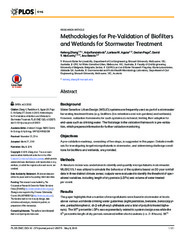Приказ основних података о документу
Methodologies for Pre-Validation of Biofilters and Wetlands for Stormwater Treatment
| dc.creator | Zhang, Kefeng | |
| dc.creator | Ranđelović, Anja | |
| dc.creator | Aguiar, Larissa M. | |
| dc.creator | Page, Declan | |
| dc.creator | McCarthy, David | |
| dc.creator | Deletić, Ana | |
| dc.date.accessioned | 2019-04-19T14:24:23Z | |
| dc.date.available | 2019-04-19T14:24:23Z | |
| dc.date.issued | 2015 | |
| dc.identifier.issn | 1932-6203 | |
| dc.identifier.uri | https://grafar.grf.bg.ac.rs/handle/123456789/714 | |
| dc.description.abstract | Background Water Sensitive Urban Design (WSUD) systems are frequently used as part of a stormwater harvesting treatment trains (e.g. biofilters (bio-retentions and rain-gardens) and wetlands). However, validation frameworks for such systems do not exist, limiting their adoption for end-uses such as drinking water. The first stage in the validation framework is pre-validation, which prepares information for further validation monitoring. Objectives A pre-validation roadmap, consisting of five steps, is suggested in this paper. Detailed methods for investigating target micropollutants in stormwater, and determining challenge conditions for biofilters and wetlands, are provided. Methods A literature review was undertaken to identify and quantify micropollutants in stormwater. MUSIC V5.1 was utilized to simulate the behaviour of the systems based on 30-year rainfall data in three distinct climate zones; outputs were evaluated to identify the threshold of operational variables, including length of dry periods (LDPs) and volume of water treated per event. Results The paper highlights that a number of micropollutants were found in stormwater at levels above various worldwide drinking water guidelines (eight pesticides, benzene, benzo(a) pyrene, pentachlorophenol, di-(2-ethylhexyl)-phthalate and a total of polychlorinated biphenyls). The 95th percentile LDPs was exponentially related to system design area while the 5th percentile length of dry periods remained within short durations (i.e. 2-8 hours). 95th percentile volume of water treated per event was exponentially related to system design area as a percentage of an impervious catchment area. Conclusions The out-comings of this study show that pre-validation could be completed through a roadmap consisting of a series of steps; this will help in the validation of stormwater treatment systems. | en |
| dc.publisher | Public Library of Science | |
| dc.relation | Cooperative Research Centre for Water Sensitive Cities E04105 | |
| dc.relation | Chinese Scholarship Council 2011609012 | |
| dc.rights | openAccess | |
| dc.rights.uri | https://creativecommons.org/licenses/by/4.0/ | |
| dc.source | PLOS One | |
| dc.title | Methodologies for Pre-Validation of Biofilters and Wetlands for Stormwater Treatment | en |
| dc.type | article | |
| dc.rights.license | BY | |
| dc.citation.issue | 5 | |
| dc.citation.other | 10(5): - | |
| dc.citation.rank | M21 | |
| dc.citation.volume | 10 | |
| dc.identifier.doi | 10.1371/journal.pone.0125979 | |
| dc.identifier.fulltext | https://grafar.grf.bg.ac.rs//bitstream/id/4112/712.pdf | |
| dc.identifier.pmid | 25955688 | |
| dc.identifier.scopus | 2-s2.0-84948420446 | |
| dc.identifier.wos | 000356768100087 | |
| dc.type.version | publishedVersion |

